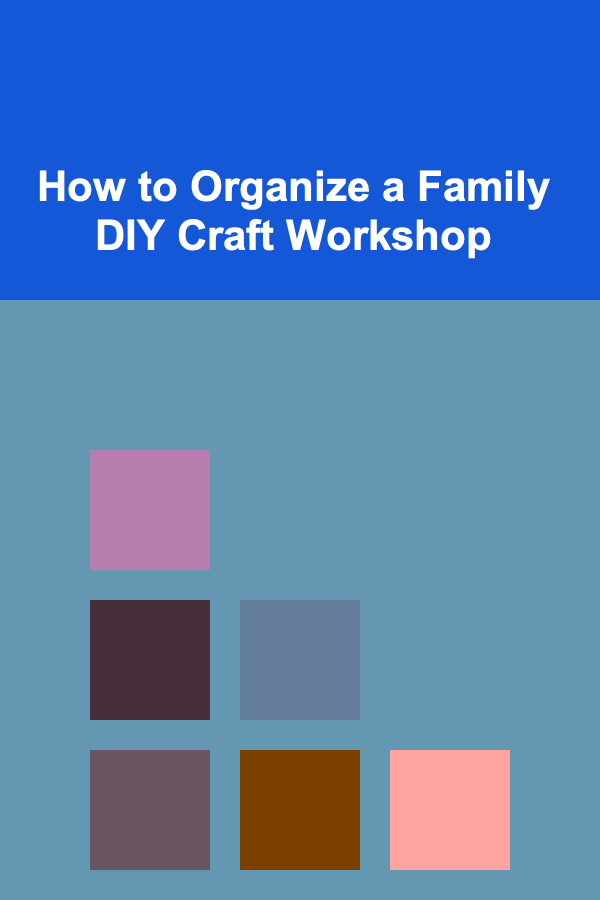
How to Organize a Family DIY Craft Workshop
ebook include PDF & Audio bundle (Micro Guide)
$12.99$8.99
Limited Time Offer! Order within the next:

Crafting is a wonderful way to engage the entire family in a creative and rewarding activity. Whether you're looking to make handmade decorations, personalized gifts, or simply spend quality time together, organizing a family DIY craft workshop can be an enriching experience for everyone involved. It's not just about the end product---it's about the joy of creating something with your own hands, the conversations that unfold during the process, and the shared satisfaction of accomplishing a project together.
In this guide, we'll walk you through the process of organizing a family DIY craft workshop. From choosing the right projects to setting up your crafting space, we'll provide tips and insights to ensure that the workshop is fun, organized, and memorable.
Choosing the Right Craft Projects for Your Family
The first step in organizing a family DIY craft workshop is selecting the projects you want to work on. This can depend on several factors such as the age and interests of the participants, the time available, and the materials you have at hand. A successful workshop is one where everyone feels involved, challenged, and excited to participate.
1.1 Consider the Age and Skill Level of Participants
Before deciding on the projects, take into account the ages and skills of your family members. Younger children may need simpler projects that require less intricate work, while older kids and adults may enjoy more complex crafts. It's important to balance the difficulty level so that everyone feels included and motivated.
- For younger children (4-7 years): Simple crafts like paper plate masks, handprint art, and basic beading projects are great options. These crafts usually involve basic materials and have easy-to-follow steps.
- For older children (8-12 years): Projects like homemade jewelry, painted picture frames, or creating simple DIY photo albums are more appropriate. They can also start learning about basic sewing or woodworking if they're ready for it.
- For teenagers and adults: More intricate projects like DIY home décor, custom t-shirts, or small woodworking tasks can be exciting. You could also dive into upcycling projects, creating art with repurposed materials.
1.2 Align Projects with Family Interests
Choosing a craft that resonates with your family's interests will help keep everyone engaged. If your family loves nature, you could focus on eco-friendly crafts like making terrariums, planting succulents in handmade pots, or creating birdhouses. If your family enjoys the holiday season, you might want to focus on making holiday ornaments, wreaths, or other seasonal decorations.
1.3 Plan for Variety
Including a variety of crafts can ensure there is something for everyone to enjoy. You might consider having a few different stations set up for different activities, allowing people to rotate between projects if they wish. For example, one table could focus on painting, another on clay crafting, and another on simple sewing or embroidery. This will give family members the freedom to explore different mediums and choose the activities they find most interesting.
Setting Up Your Crafting Space
A well-organized crafting space is essential for a successful family DIY craft workshop. This will ensure that everyone has enough room to work, that materials are easy to access, and that the space is safe for all ages.
2.1 Choose the Right Location
The location for your DIY craft workshop should be spacious enough to accommodate everyone comfortably. Consider areas such as:
- A dining room or kitchen: If you have a large table, this can serve as a great workspace. Just be sure to cover the table with a protective cloth or plastic to avoid damage from paint or glue.
- A garage or basement: These areas are ideal if you have access to tools for more hands-on projects like woodworking or upcycling. They are also great for messy activities like spray painting.
- An outdoor area: If the weather permits, crafting outside in the backyard can provide plenty of space and fresh air. Just be sure to have shaded areas and outdoor furniture where people can sit and work.
2.2 Organize Materials and Tools
Organizing your materials before the workshop begins is crucial for keeping the creative process flowing smoothly. Having everything laid out and ready to go will save you time and reduce frustration. Here's how to organize your materials:
- Storage bins or trays: Store smaller items like beads, buttons, sequins, and paints in clear plastic containers or trays for easy access.
- Workstations: Set up different workstations for each craft project. Each station should have its own materials, tools, and instructions, making it easier for people to focus on their chosen activity.
- Common materials: Ensure that there are shared materials available for everyone, such as scissors, glue, tape, markers, and brushes. These should be easily accessible for anyone who needs them.
- Cover surfaces: Protect your tables or work surfaces with newspapers, disposable tablecloths, or plastic sheets. This will help avoid spills and make clean-up easier.
2.3 Ensure Safety
Safety should be a top priority when crafting with children or inexperienced crafters. Depending on the activities, you may need to:
- Supervise the use of sharp tools: Ensure that young children don't handle scissors or craft knives unsupervised. If older children or teenagers are using sharp tools, make sure they're using them correctly and safely.
- Use non-toxic materials: Opt for non-toxic paints, glues, and markers, especially if younger children will be involved.
- Have a first aid kit: Accidents can happen, so it's wise to have a first aid kit on hand, just in case.
Plan the Workshop Schedule
A good schedule can keep the workshop running smoothly and ensure that everyone stays on task and has a chance to finish their projects.
3.1 Set a Time Frame
It's important to decide how long the workshop will last. A good length of time for a family DIY craft workshop is typically 2-4 hours, depending on the complexity of the projects. You can also break the workshop into multiple sessions if you plan on tackling more complex projects.
3.2 Organize Crafting Time and Breaks
It's essential to balance crafting time with breaks. Crafting can be tiring, especially for younger children. Plan for regular breaks to let participants stretch, grab a snack, or simply relax for a moment.
A sample schedule might look like this:
- Welcome and introductions (10 minutes): Start by introducing the craft projects and giving a brief overview of the schedule.
- First crafting session (45 minutes): Start the first project, giving everyone time to work.
- Break (10 minutes): Encourage people to step away from their workstations for a quick break.
- Second crafting session (45 minutes): Move on to a new project or continue with the first one, depending on the complexity.
- Final touches and clean-up (30 minutes): Allow time for finishing projects and cleaning up the space.
3.3 Set Up a Show-and-Tell Time
At the end of the workshop, have a small "show-and-tell" time where everyone can present their completed projects. This is a great way to encourage pride in their work and to admire the creativity of others. It also provides an opportunity for family members to give and receive positive feedback.
Gather Necessary Materials and Tools
Now that you have your projects, space, and schedule set, it's time to gather all the necessary materials and tools.
4.1 Crafting Supplies
The materials you need will depend on the specific crafts you choose. Some basic supplies you should have on hand include:
- Paper: Construction paper, cardstock, and scrapbooking paper.
- Paint and Markers: Acrylic paints, watercolors, markers, and colored pencils.
- Glue and Tape: White glue, hot glue guns, double-sided tape, and glue sticks.
- Fabric and Thread: For sewing or embroidery projects, gather a variety of fabric, thread, needles, and buttons.
- Beads and Jewelry-making supplies: If you're doing jewelry crafts, have beads, wires, clasps, and pliers.
- Tools: Scissors, craft knives, paintbrushes, rulers, and measuring tapes.
4.2 Budgeting for Supplies
If you're on a budget, there are plenty of ways to reduce costs:
- Use upcycled materials: Recycle materials such as old magazines, cereal boxes, fabric scraps, or buttons from old clothes.
- Buy in bulk: Many craft stores offer discounts when you buy in bulk, especially for materials like glue, paint, or beads.
- Check for free materials: Sometimes, you can find free or inexpensive craft materials at local thrift stores or online marketplaces.
4.3 Preparing Craft Kits
If you have a larger group or want to ensure that everyone has all the necessary materials, consider preparing craft kits. These can be made in advance, ensuring that each participant has the materials they need for their project.
Engage and Inspire Your Family
Finally, to make the workshop truly special, consider ways to engage and inspire your family throughout the process.
5.1 Encourage Creativity
While it's tempting to provide a step-by-step guide for everyone to follow, consider encouraging creative freedom. Allow your family to add their own personal touch to their projects. This could be through color choices, unique design elements, or embellishments that reflect their personality.
5.2 Foster Teamwork
Crafting can be a great way to foster teamwork within the family. Consider planning projects that involve collaboration, such as creating a large family mural or working together to design a collaborative quilt. This will encourage communication and cooperation.
5.3 Be Flexible and Have Fun
Above all, remember that the goal is to have fun and make memories. Be flexible with the schedule and project details. Sometimes the most enjoyable moments come when things don't go exactly as planned. Let the process be about enjoyment, not perfection.
Conclusion
Organizing a family DIY craft workshop is an incredible way to bring your family together for creative fun. With careful planning, the right materials, and a focus on enjoyment, you can create an environment where everyone feels inspired to make something special. Crafting not only provides a fun experience, but it also fosters creativity, problem-solving, and collaboration---all essential skills for any family. Whether you're crafting for holidays, gifts, or just for fun, a family DIY workshop will leave you with lasting memories and beautiful handmade items to cherish.
Other Products

How to Add Personality and Style to Your Home Renovation
Read More
How to Categorize Your Pantry Items for Easy Access
Read More
How to Make Your Rental Property Pet-Friendly
Read More
How to Manage Your Home Budget During Job Transitions
Read More
How to Set Up a Family Game Zone That Everyone Will Love
Read More